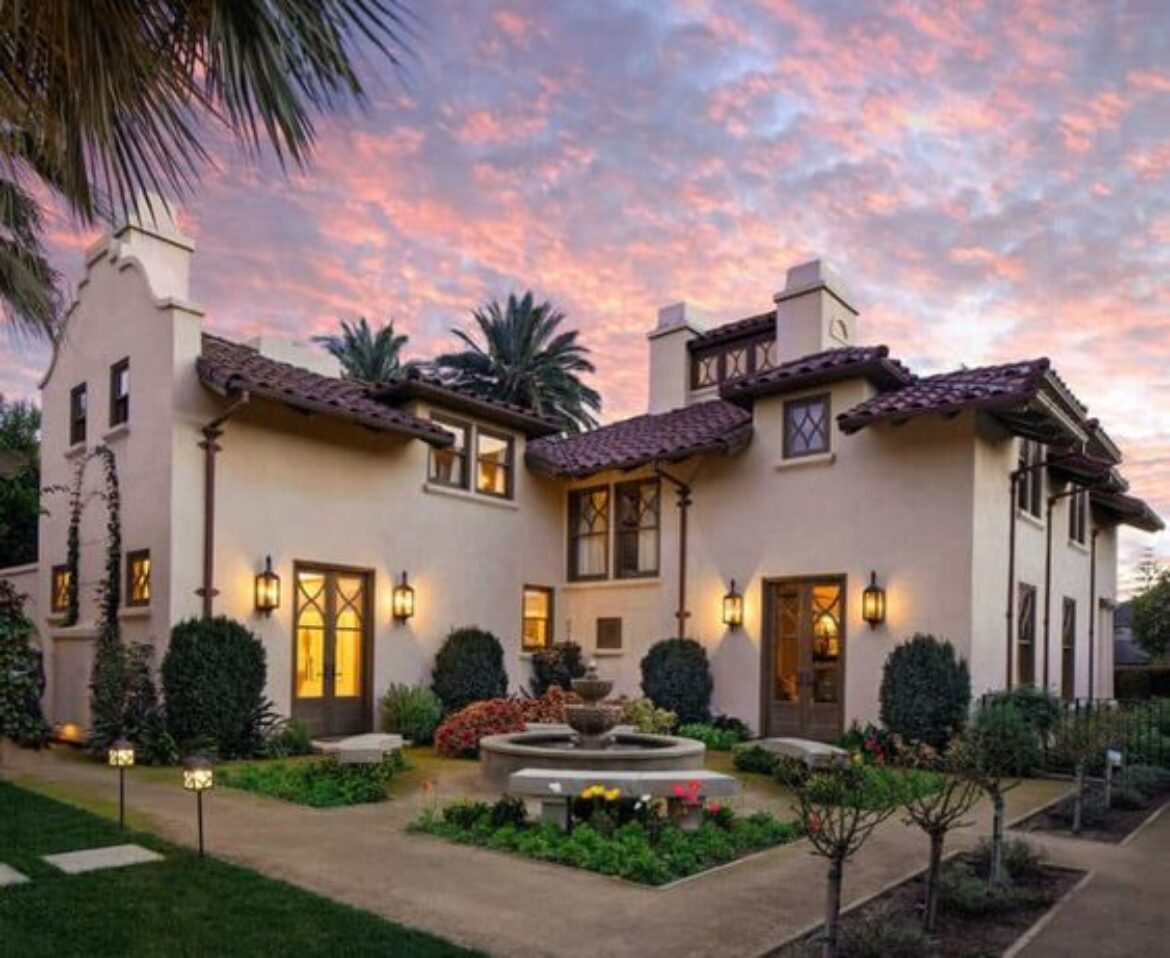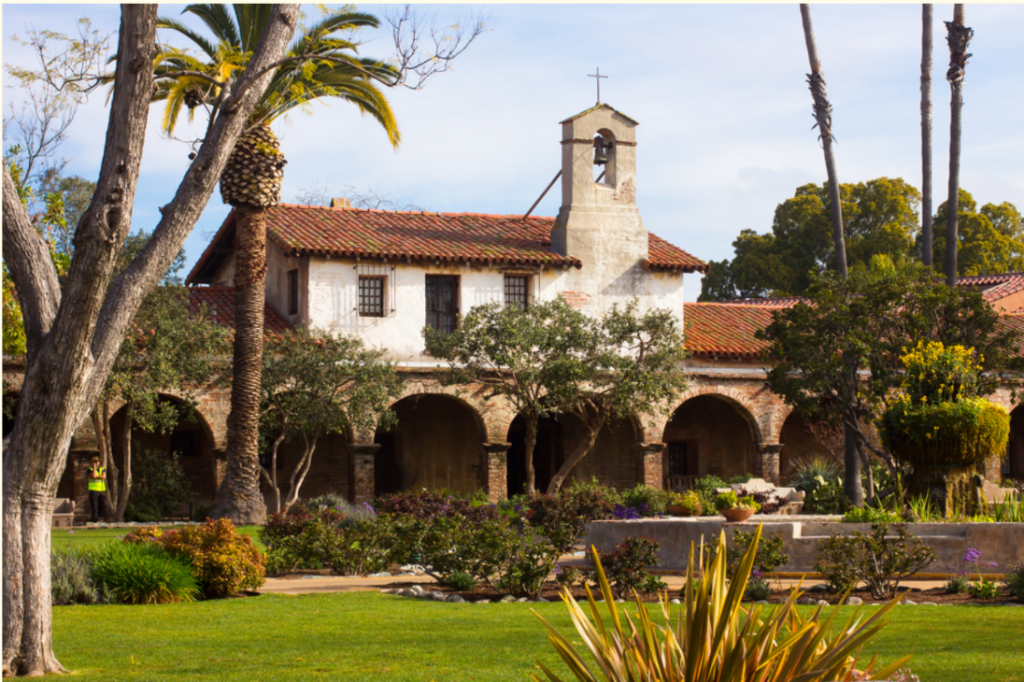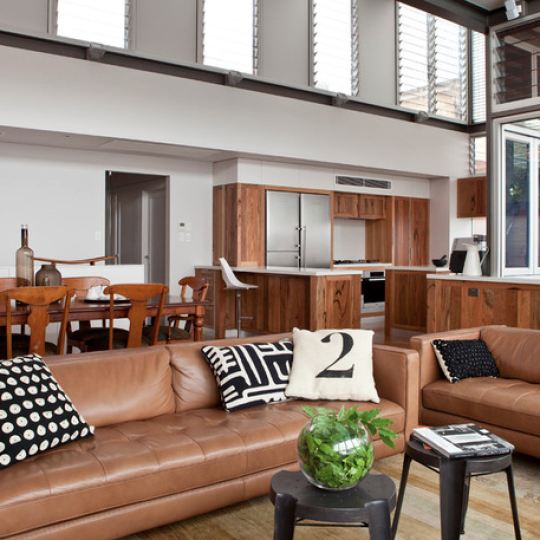Driving up Highway 101 along the coast of California, you will see a lot of signs for “El Camino Real” and often a curved post with a bell attached. These bells indicate the old Mission Trail, which connects a series of 21 Franciscan missions built in Alta California in the 18th century. For those of us who didn’t grow up in California, the “Mission Revival” style of architecture which dominated late 19th and early 20th century development may not be familiar but it’s one we at Talie Jane Interiors have come to love.
What is California Mission Style?
The Mission Revival style is one of California’s most famous architectural styles. For instance, red clay tile roofing with a low pitch, plain stucco exteriors, and arches characterize this style, which evolved from old missions. Mission Revival homes are trendy because of the thick wall systems that assist keep the pleasant breeze in and the searing heat out.
These dwellings are usually modest but have much historical significance. A second story is prevalent in today’s Mission Revival, with the classification of single-story Mission residences as bungalows. With these properties having such qualities, they will never get old and remain iconic as long as they stand.
The emphasis is always on allowing the finished materials and surfaces to show the hand of the craftsman. Beams are often hewn by hand, and decorative details hand carved.
Mission-style architecture is prevalent throughout the southwestern states, including California, New Mexico, and Texas. Reviving elements of Spanish architecture, this popular building style includes terracotta tile roofs, white stucco, and decorative tile work. On the interior, the mission style is characterized by white/light-colored walls, dark-stained or reclaimed beams, colorful tiles, and terracotta flooring.
The History
Originating in California, the Mission Revival architecture style pays homage to the Hispanic history and heritage of the Golden State. The style became popular amongst residential developers as a way to complement the vast landscapes and invoke a romanticized feeling of the lost Spanish past.
The Mission Revival style was born in California in the early 1890s when the California Building at the World’s Columbian Exposition was constructed in a style that recalled the Spanish mission architecture of California’s past.
The defining characteristics of the style are its Mission-shaped dormers or parapet walls and the addition of Islamic architectural details, which made its way into historic Mission architecture through the Spanish.
At the end of the 19th century, Mission Revival was considered the architectural style most congenial to the landscape and heritage of California. Books and periodicals romanticized the lost Spanish past while commercial brochures promoted an arcadian present to lure businesses, residents, and tourists. The standard California Mission design elements (tiled roofs, stucco walls, arches, and arcades) were soon popular in railroad stations, schools, commercial buildings, and houses all over California.
Defining Features
Exterior
California Mission Style house plans share the stucco walls and red tile roofs common to the other architectural styles indigenous to California and America’s Southwest, but they have one distinguishing feature: at least one curvaceous parapet adorning the façade. A parapet is a wall that extends above the roof, and that roof may be the roof of the home or the roof of one element of the home, like the porch or a dormer window. Some Mission home designs have more than one of the characteristic parapets, and some even boast another special feature of a Spanish Mission: a bell tower.
TERRACOTTA TILE ROOF
When identifying a Mission-style home, a terracotta tile roof is one of the easiest elements to spot. Terracotta roof tiles are made from fired clay and feature a rich red-orange color. They are traditionally curved, interlocking plates. Terracotta roofs are almost exclusively used in Mission and Mediterranean architecture.
WHITE STUCCO
Classic Mission homes feature white stucco exteriors that allow their terracotta roofs, black ironwork, and tile details to shine. While most Mission homes are white, some other popular stucco colors include pink, yellow, or orange.
TILE ACCENTS
Mission architecture takes inspiration from the Art Nouveau movement with exterior hand-painted tilework inspired by nature. Patterns may feature organic forms inspired by flowers and colors like blue, white, and orange. Tile accents can be found on stairs, window borders, and decorative alcoves.
QUATREFOIL WINDOWS
Quatrefoil windows, vents, or openings are often used in more ornate Mission-style home designs. They typically appear on dormers or above the main doorway to bring attention and define a focal point of the exterior.
ARCHES
Arches are a common motif among Mission-style homes. Arches may appear on front porch entryways, windows, and even the front door.
Interior
Not only is the outside of a mission-style home eye-catching, but so is its interior. Homes interiors are made of dark wood including the baseboards and plank floors. The dark interiors are well-suited for warmer climates. Foyers are grand with a Spanish-style chandelier and terracotta tile. A suite of rooms and doorways in line with each other. Decorative wrought iron, arches, and built-in niches and alcoves throughout the home. Decorative hand-painted tiles can be found on stair risers and in kitchens. Wooden beams also line the ceilings.
TILE FLOORS
The Spanish influence of the Mission style carries through to the interior in the form of tile flooring. Terracotta floor tiles are common and may include hand-painted accents in colors like blue and green.
STONE FIREPLACES AND TILE SURROUNDS
It is common to see nods to nature in Mission homes, and the fireplace is a popular spot to do so. Mission fireplaces may feature stone, plaster, or hand-painted tile surrounds, bringing in colors and patterns found in the natural world.
ORNATE IRON STAIR RAILINGS
Mission homes are known for their elaborate iron stair railings. Drawing inspiration from old-world Spanish architecture, Mission staircases may feature hand-painted tiles and various ironwork patterns.
LIGHT-COLORED WALLS
Most commonly, white or cream-colored walls drench the interior walls to better accentuate the dark beams and decorative tile elements.
Kitchens
A Mission style home should also feature a Mission style kitchen. Mission-style kitchens tend to have more simple, unadorned hardwoods, often with expertly carved paneling or cutouts. Inspiration comes from the historic Spanish missions in California, blending rustic simplicity with functional elegance. Here are the key elements that define a kitchen in this style:
RUSTIC WOODEN FURNITURE
Simple, sturdy wooden tables, benches, and cabinetry are key features. Often, these pieces are made from dark, reclaimed wood.
OPEN SHELVING
Wooden shelves are used for storing utensils, dishes, and ingredients, keeping with the open and airy feel of the space.
ATURAL MATERIALS
Wood, stone, and clay are extensively used to create a natural, organic feel.
TILE ACCENTS
Decorative Spanish or Talavera tiles are used as accents in backsplashes, countertops, and sometimes even floors.
EARTH TONES
Warm, earthy colors like terracotta, ochre, and deep browns are dominant.
NEUTRAL WHITES AND CREAMS
Light, neutral colors are used to balance the warmth and keep the space feeling light and open.
WROUGHT IRON HARDWARE
Iron handles, light fixtures, and decorative elements add to the rustic, old-world feel.
HANDMADE POTTERY
Clay pots, bowls, and other pottery items are both functional and decorative, contributing to the handcrafted look.
Mission Style is far from being over and will continue to evolve. The best part about Mission style is that you don’t need to have a famous mansion, or a church to achieve this style. Taking a few elements away from the Mission style can add charm and style to any home. Whether it is using colorful patterned tiles, arches, dark reclaimed beams, ornate wrought iron balusters, or a beautiful vintage southwestern door you scored at your local market, the Mission Style can be added to any home in moderation, or maximization!
Never a Fad” Interestingly, the Mission Revival architecture style was never a fad, unlike the proceeding trends and genres in the 1920s and 1930s, where entire neighborhoods were designed in the same trendy style – like Craftsman and Spanish Colonial.
A Modern Take on Mission
The Mission style remains popular in the Southwest today for its ties to history and its timeless look that can take on a cozy or contemporary feel architectural element, including white stucco, terracotta tile roofing, and an iron staircase, pair alongside streamlined contemporary features, like massive stacking glass sliding doors. This regional style continues to grow and take on a new life for a new age of design!
Modern Mission is capturing the defining features such as deep-cut windows, you can see the arches being traded for a square shape. While the terracotta tile roof and light stucco still maintain the authentic mission style.
Modern Mission Interiors utilize the same idea, using the defining features of mission style. Arched windows and entry frames, thick contrasting dark furniture pieces and beams, while adding modern elements such as clean crisp lines, and modern lighting.
If you are interested in taking the plunge to have a Mission Style Home or Inspired Mission Style Home, please give the team at Talie Jane Interiors a call and we will match your dream to reality!
Contact us at 855-TALIE JANE (855-825-4352)
Article by Talie Jane Interiors Team.
Sourcing:
https://www.studiodk.com/blog//mission-style-homes-and-architectures
https://structurehome.com/california-mission-architecture/
https://isarchitecture.com/style-101-mission-revival/
https://structurehome.com/california-mission-architecture/
https://www.alvarezhomes.com/characteristics-of-mission-style-homes/
https://www.studiodk.com/blog//mission-style-homes-and-architectures
Images: Pinterest, Google Images






















Sorry, the comment form is closed at this time.